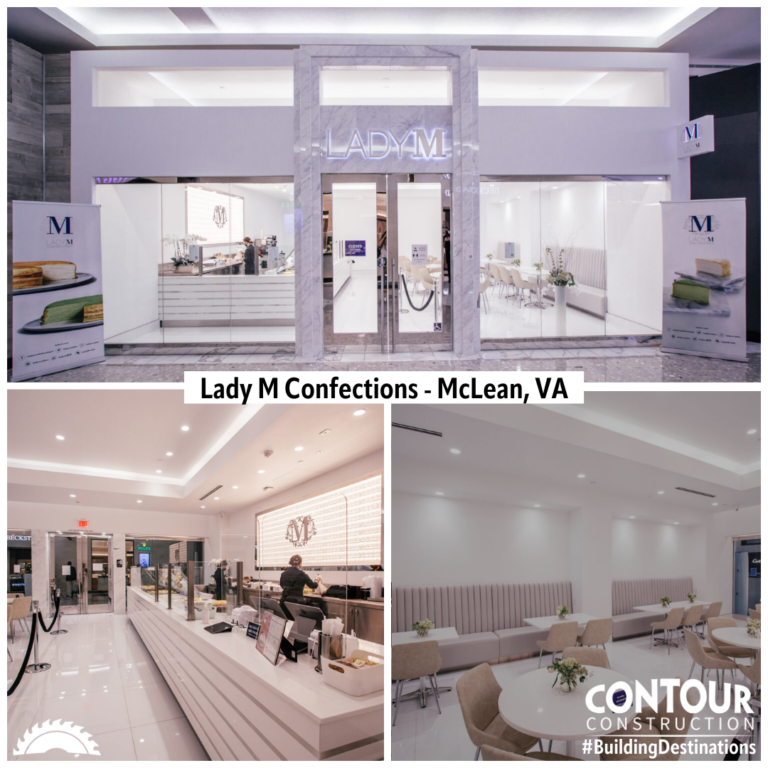At Contour Construction, we’ve seen a surge in demand for interior renovations that align with the evolving needs of modern businesses. In 2024, companies are focusing on creating commercial spaces that enhance both functionality and experience. These trends focus on implementing design ideas such as flexible layouts, sustainable materials, and smart technology to meet modern demands. As a trusted general contractor, we are helping businesses transform their commercial spaces to reflect these innovations, while making sure that each renovation is executed with precision and quality.
While we bring these construction projects to life, industry leaders like Gensler and HOK are driving the design concepts that inspire these trends. These firms introduce elements like adaptable spaces, biophilic design, and advanced technology, which Contour Construction implements as part of a seamless renovation process. Discover more about how these trends can reshape your space by visiting our website at www.contour-gc.com.

Trend | Key Features | Benefits | Examples |
|---|---|---|---|
Custom and Unique Furnishings | Bespoke furniture reflecting brand identity | Enhances aesthetic appeal and maximizes space | Custom-built reception desks, modular seating |
Open-Concept Spaces and Flexibility | Open layouts fostering collaboration and creativity | Better teamwork, improved space use, natural light | Adaptable spaces for meetings, creative zones |
Upgraded Common Areas | Comfortable seating, tech-friendly zones, stylish décor | Boosts morale, encourages casual interactions | Lounge chairs, coffee bars, charging stations |
Safety and Accessibility Enhancements | Smart safety features, accessible restrooms, ramps, wider doorways | Inclusivity, safety, compliance with standards | Touchless entry, fire suppression, air monitoring |
Sustainable and Smart Technology Integration | Green building practices, smart lighting, energy-efficient systems | Reduces energy consumption, aligns with sustainability | Smart thermostats, motion-sensor faucets, solar panels |
Retail and Display Updates | Interactive and immersive retail displays | Engages customers, boosts foot traffic | Custom lighting setups, digital display boards |
Mixed-Use and Multi-Purpose Spaces | Spaces blending work, shopping, and leisure | Increases revenue, promotes work-life balance | Urban developments with offices, shops, and cafes |
Modernized Medical and Hospitality Spaces | Comfort-focused designs, smart technology, patient- and guest-centric layouts | Improves well-being, reduces stress, enhances experience | Telemedicine stations, spa-inspired bathrooms |
Fit-Out Type | Cost Implications | Timelines |
|---|---|---|
Shell & Core Fit-Out | Higher costs due to starting from an unfinished shell | Longer timelines, as it involves significant work |
Category A Fit-Out | Moderate costs; basic interior elements are installed | Medium timelines; completing standard essentials |
Category B Fit-Out | Higher costs for customization and additional details | Varies; depends on the level of customization |
Turnkey Fit-Out | Typically the highest cost, but includes all services | Shorter timelines as it’s handled start-to-finish |
1) Custom and Unique Furnishings
Custom and unique furnishings have become a hallmark of modern commercial spaces, allowing businesses to create a distinct identity and leave a lasting impression on visitors. By incorporating bespoke pieces, companies can tailor their environments to reflect their brand and culture, whether it’s through bold statement furniture or functional designs that maximize space. For example, a custom-built reception desk can instantly elevate the professionalism of an office, while modular seating in a collaborative space promotes creativity and flexibility. These one-of-a-kind pieces not only enhance aesthetics but also ensure that every inch of the space is optimized for purpose and style.

2) Open-Concept Spaces and Flexibility
Open-concept spaces are quickly becoming the go-to layout for modern commercial properties, offering a welcoming and versatile environment that fosters collaboration and creativity. These flexible layouts break down physical barriers, creating a sense of openness that encourages teamwork and makes spaces feel more inviting. By allowing for easy reconfiguration, businesses can adapt their spaces to meet changing needs, whether it’s for impromptu meetings or large group gatherings. The increased flow of natural light and improved spatial efficiency are just a few of the perks that make open-concept spaces ideal for promoting productivity and a positive workplace atmosphere.


3) Upgraded Common Areas in Office Spaces
Upgrading common areas has become a key trend in making office spaces more inviting and enjoyable for employees and visitors alike. By incorporating comfortable seating, tech-friendly zones, and stylish décor, these areas transform into vibrant hubs for collaboration and relaxation. Trendy additions like lounge chairs, charging stations, and even coffee bar setups encourage casual interactions and provide a break from traditional workspaces. These upgraded spaces not only boost morale but also enhance productivity by offering employees a comfortable place to recharge and connect in a more relaxed setting.


4) Safety and Accessibility Enhancements
Safety and accessibility have become essential priorities in modern commercial renovations, ensuring that buildings are not only secure but also welcoming to everyone. Today’s renovations are focused on creating environments that meet the needs of all users, from employees and clients to visitors with mobility challenges. This includes installing wider doorways, ramps, and accessible restrooms, as well as upgrading lighting and signage to ensure that spaces are easy to navigate. In offices, hospitals, hotels, and retail spaces, these changes enhance the overall functionality of the building while providing a safe, comfortable experience for all occupants.
Additionally, advancements in technology have made it easier to incorporate smart safety features into commercial spaces. From touchless entry systems to advanced fire suppression and air quality monitoring, businesses are leveraging technology to create safer environments. These innovations not only protect the health and well-being of occupants but also ensure compliance with modern safety standards. By making safety and accessibility integral to their renovations, businesses demonstrate a commitment to inclusivity and the well-being of everyone who interacts with their space.

5) Sustainable and Smart Technology Integration
In 2024, sustainability and smart technology have become key drivers in commercial renovations, helping businesses reduce their environmental impact while saving energy and cutting costs. From offices to hospitals and hotels, buildings are going green by incorporating energy-efficient lighting systems, smart thermostats, and solar panels. These innovations not only lower utility costs but also contribute to a building’s eco-friendly footprint, aligning with the growing demand for sustainable practices. For example, smart lighting systems that adjust based on occupancy and natural light can significantly reduce energy consumption, while motion-sensor faucets in restrooms conserve water.
Additionally, smart technology integration is revolutionizing building management by streamlining operations and improving efficiency. In hospitals, for instance, smart HVAC systems can monitor air quality and adjust settings to maintain optimal health conditions for patients. In hotels, keyless entry systems and automated room controls enhance the guest experience while minimizing energy waste. By embracing sustainable and smart technologies, businesses are not only enhancing the functionality of their spaces but also demonstrating their commitment to environmental responsibility, which can positively impact their brand and bottom line.
Technology | Energy Savings (%) | Example Usage |
|---|---|---|
Smart Lighting Systems | 30 | Office spaces with occupancy-based lighting controls |
Smart Thermostats | 20 | Hotels with automated temperature settings |
Solar Panels | 40 | Hospitals utilizing solar energy for powering equipment |


6) Retail and Display Updates
In retail design, the latest trends are all about creating interactive, immersive shopping experiences that draw customers in and keep them engaged. From innovative lighting setups to digital displays, stores are transforming their spaces to enhance the shopping journey. Creative, eye-catching displays are at the forefront of this movement, serving as both a focal point and a marketing tool. These displays can be customized to reflect seasonal trends, promotions, or brand storytelling, helping retailers capture attention and boost foot traffic. By making shopping more dynamic and visually appealing, businesses can create memorable experiences that encourage customers to return.

7) Mixed-Use and Multi-Purpose Spaces
The trend of mixed-use and multi-purpose spaces is transforming commercial real estate by blending work, shopping, and leisure activities into one dynamic location. These versatile spaces cater to a variety of needs, allowing visitors to accomplish multiple tasks in a single trip—whether it’s grabbing coffee, shopping, or attending a meeting. For business owners, this flexibility maximizes the use of their property, creating multiple revenue streams and increasing foot traffic. Mixed-use developments, often found in urban commercial centers, are designed to offer convenience and community engagement, making them appealing to both tenants and consumers.
The benefits extend beyond financial gains for property owners. These spaces also promote work-life balance by offering accessible amenities, fostering a sense of community, and encouraging collaboration. Offices located within mixed-use developments often have immediate access to retail, dining, and recreational areas, enhancing employee satisfaction and productivity. Visitors, too, appreciate the convenience of having everything in one place, creating a seamless, enjoyable experience. As this trend continues to grow, it’s clear that the future of commercial spaces is all about flexibility and adaptability.
Metric | Before Renovation | After Renovation |
|---|---|---|
Employee Productivity | 65% | 85% |
Energy Efficiency | 50% | 80% |
Client Experience | 70% | 90% |

8) Modernized Medical and Hospitality Spaces
The modernization of medical and hospitality spaces is focused on enhancing comfort, care, and overall experience for patients and guests alike. In healthcare, the latest designs are incorporating patient-centered layouts, with private rooms, natural lighting, and calming décor to create a more welcoming and less clinical environment. These spaces are also integrating technology like telemedicine stations and smart beds, which improve patient care by enabling healthcare providers to monitor vital signs in real-time. The goal is to create a healing environment that reduces stress and anxiety while making medical care more efficient and effective.
In hospitality, the focus is on combining luxury and convenience. Hotels are upgrading their interiors with high-end finishes, comfortable furniture, and personalized technology such as keyless entry and in-room digital assistants. Wellness features, like spa-inspired bathrooms and fitness centers, are being added to cater to health-conscious guests. By blending comfort with cutting-edge technology, these updates ensure that both patients and guests have a more relaxing, seamless experience, whether they’re recovering from a procedure or enjoying a vacation.


Learn More About Commercial Interior Renovations
As commercial spaces continue to evolve, renovation trends are moving toward creating environments that are both functional and inspiring. From open-concept layouts that foster collaboration to sustainable materials that reduce environmental impact, businesses are prioritizing spaces that meet the demands of modern employees and clients. Trends like custom furnishings, smart technology integration, and upgraded common areas are shaping the future of commercial interiors, helping companies stand out while optimizing the use of space. Whether it’s a full renovation or a simple refresh, these trends reflect the need for flexibility, comfort, and innovation in today’s commercial properties.
To dive deeper into how these renovation trends can benefit your business, check out this article on Commercial Design Trends for 2024. When you’re ready to bring these ideas to life, Contour Construction is the partner you need. From interior fit-ups and improvements to full-scale renovations and new concept rollouts, we handle every aspect of commercial interior renovations with the utmost precision and dedication. Our team delivers high-quality work tailored to your unique business goals, ensuring that your space is ready to meet the demands of the future. Trust Contour Construction to deliver exceptional results on your next renovation project.




